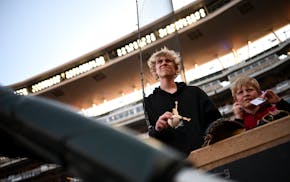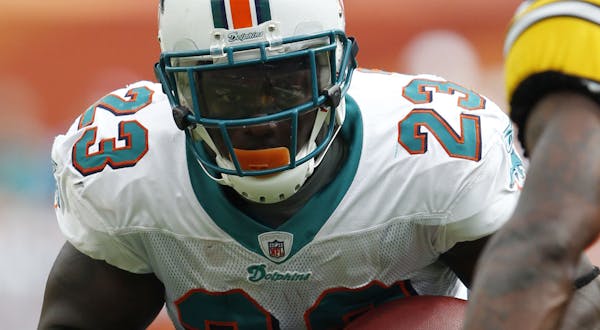Shortly after Dalvin Cook planted his left leg in the U.S. Bank Stadium turf Sunday and felt his knee buckle, instinctively grabbing it with his left hand as the Lions' Tavon Wilson dislodged the ball from Cook's right arm, it felt as if the rookie running back's predicament had stolen the breath from the 66,730 in attendance.
But though coach Mike Zimmer first mentioned the term "ACL" in a somber tone after the Vikings' 14-7 loss to the Lions, it cast nowhere near the pall on Cook's career that it once might have.
"I told him, he's not the first great running back to have an ACL, if it is one, and come back pretty good," Zimmer said. "Dalvin will have a great career."
To be sure, the prospects for Cook's return are good. He has modern medicine — and the example of running backs such as Adrian Peterson — to thank for that. A Northwestern Medicine study showed that 80 percent of NFL players return to play after undergoing an orthopedic procedure like an ACL repair, and Peterson's stirring performance — winning MVP honors and rushing for 2,097 yards after making a nine-month recovery from a torn ACL in 2012 — helped to demystify the injury to some degree.
Surgical procedures are more precise, rehab programs are more effective and players are more prepared to return in full form from an injury that might once have ended a career.
The peak of Peterson's post-ACL career came when he was 27, while Cook will try to return at age 23. That could help in one sense, since Cook's youth could lead to a fuller recovery. The Northwestern study, though, indicates that Peterson's remarkable rebound was unique, while offering concerning numbers about players' longevity after knee surgery.
The Northwestern study showed players experience significant declines in their performance, compared to their pre-injury levels, for as long as three years after surgery. Dr. Harry Mai, a lead author of the study, said last year that most players recover 80 percent of their pre-injury performance. And according to the study, the average player spends only another 1.6 seasons in the league after the injury.
Dr. Bert Mandelbaum, a Santa Monica-based orthopedic surgeon and ACL injury prevention researcher at the Kerlan-Jobe Institute, also said players who tear their ACL are 10 times more likely to tear the same ACL again, or tear the ACL in their opposite knee.
"You can make a difference by training what we call neuromuscular control," Mandelbaum said. "One of the things we talk about with athletes is, they can be big, they can be strong, they can be fast and powerful, but if they don't have the capability of good steering, just like an IndyCar — it's big, fast, goes zero to 60 in two-some seconds — but if your steering is tight, you bang into the wall."
Mandelbaum cautioned there's a much wider spectrum of severity with ACL tears than the public typically acknowledges. Noncontact injuries, like Cook's, tend to be less severe because there's not as much force bearing on the knee as if a player was hit when he tears his ACL.
"The energy of the injury equals one-half of mass times velocity squared," Mandelbaum said. "So the higher, bigger, faster injuries, the more energy translates to more tissue damage. All those variables are directly related to everything from how quickly you get back to how much needs to get fixed, to the amount of consequent arthritis that occurs down the road."
Given that Cook's tear came without contact — which about 70 percent of ACL tears do, Mandelbaum said — there'd seem to be a good chance he'll have a smooth rehab and be able to return to a big role next year.
Cook also can look to a player such as fellow Miami native Frank Gore, who's made five Pro Bowls and run for more than 13,000 yards in 13 seasons after tearing his ACL in college.
But many of the post-ACL success stories have a limited shelf life; Jamaal Charles ran for 1,509 yards in 2012 and surpassed 1,000 yards each of the next two seasons, only to suffer his second ACL tear in 2015. Peterson ran for 1,266 yards in 14 games in 2013, and won a rushing title in 2015, but needed surgery after the 2012 and 2013 seasons before tearing his meniscus last season. Then there are backs such as Ronnie Brown, Edgerrin James, Rashard Mendenhall and Deuce McAllister who saw their production nose-dive after knee surgery.
Medical advances mean Cook's return in 2018 is a relatively solid bet. But while he can mimic Peterson in one respect, the tender age at which he tore his ACL — and the often-truncated career prospects for running backs after the injury — might make it harder for him to match the decadelong Viking in another.
Ben Goessling covers the Vikings for the Star Tribune. Twitter: @GoesslingStrib. E-mail: ben.goessling@startribune.com
Webb Simpson offers to resign from PGA Tour board. But only if McIlroy replaces him, AP source says

Live: Twins vs. White Sox. Follow the action on Gameview
![Glen and Becky Taylor during game 1 on Saturday, April 20, 2024, at Target Center in Minneapolis, Minn. ] CARLOS GONZALEZ • carlos.gonzalez@startri](https://arc.stimg.co/startribunemedia/X74AVHP3ZBD4TPPPDJTNX5LN6M.jpg?h=91&w=145&fit=crop&bg=999&crop=faces)
Gameview: Wolves vs. Suns in Game 2. Up-to-the-second updates here.
Paris main airport unveils new baggage handling system ahead of the 2024 Olympics

